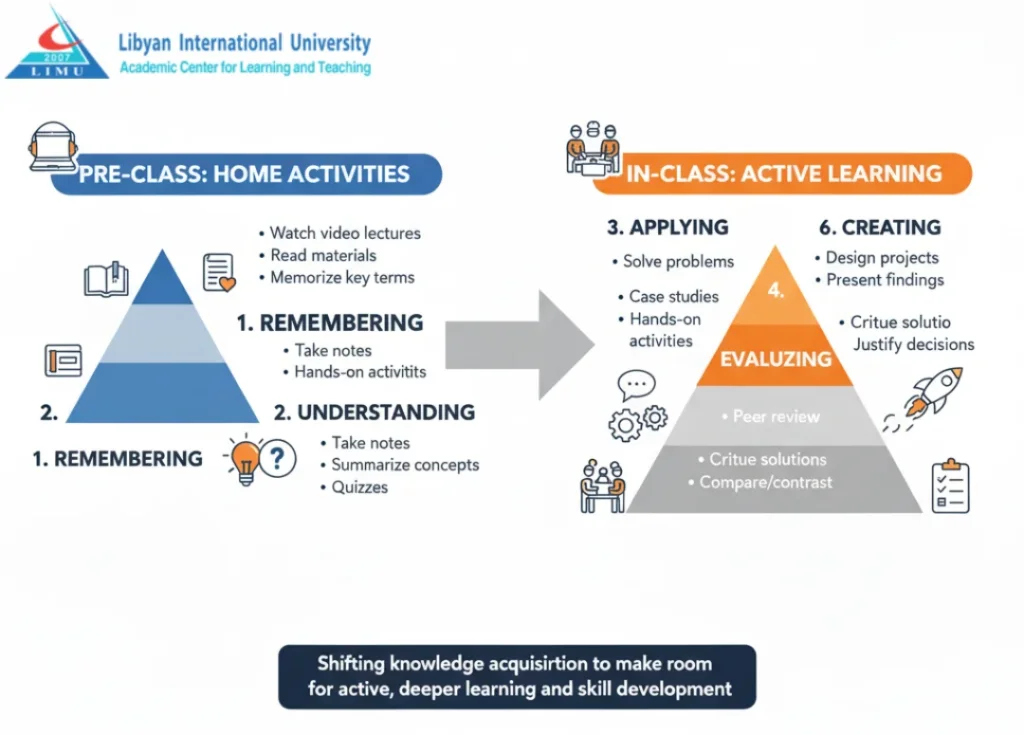Dr. Buthaina Gerriw
Education has continuously evolved to meet the changing demands of society. From memorizing facts to developing critical thinking and lifelong learning skills, teaching methods have transformed to place greater emphasis on student engagement and real-world application. Among the most innovative models reshaping modern education is the flipped classroom, a student-centered approach that reimagines the traditional teaching process.
At its core, the flipped classroom challenges one fundamental question: Should learning happen in the classroom or beyond it—and who drives it, the teacher or the learner?
Traditional Teaching: The Lecture Model
In traditional classrooms, learning often follows a predictable pattern. The teacher delivers content through lectures, and students listen, take notes, and later review the material for exams. This teacher-centered model ensures coverage of the curriculum, maintains classroom order, and provides a clear structure.
However, it also has limitations:
– Students are often passive recipients rather than active participants.
– Learning focuses on memorization rather than understanding.
– There is limited time for practice, application, or collaboration.
While effective for transmitting information, the traditional model may not fully prepare students for the complex, dynamic challenges of today’s world.
The Flipped Classroom: Turning the Model Upside Down
The flipped classroom reverses the traditional learning process. Instead of introducing new concepts during class and assigning practice as homework, students first encounter learning materials before class, often through videos, readings, or interactive modules. Classroom time is then used for discussion, collaboration, and application.
This approach transforms the teacher’s role from a “lecturer” to a facilitator of learning. Students arrive prepared, ready to engage in problem-solving, debates, and group activities that deepen understanding.
Key characteristics of the flipped classroom include:
Pre-Class Learning: Students access recorded lectures, readings, or quizzes online at their own pace.
In-Class Engagement: Class sessions are devoted to active learning—discussions, group work, case studies, and hands-on problem-solving.
Continuous Feedback: Teachers guide, clarify, and support rather than simply deliver information.

Benefits of the Flipped Classroom
Research has shown that the flipped classroom significantly enhances student engagement, motivation, and performance. Learners not only grasp course content more effectively but also develop essential 21st-century skills such as self-directed learning, communication, collaboration, and critical thinking.
1. Active Learning:
Students take ownership of their learning through exploration and participation rather than passive listening.
2. Flexibility and Accessibility:
Pre-recorded materials allow learners to study anytime, anywhere, and revisit content as needed.
3. Deeper Understanding:
Classroom time is dedicated to applying knowledge, analyzing problems, and synthesizing ideas—leading to more meaningful learning.
4. Collaboration and Interaction:
The flipped environment promotes teamwork, peer learning, and open dialogue, strengthening interpersonal and social skills.
Challenges and Considerations
Despite its advantages, the flipped classroom is not without challenges. It requires:
- Careful preparation: Teachers must design engaging pre-class materials and well-structured in-class activities.
- Technological support: Reliable access to digital platforms and devices is essential.
- Student responsibility: Learners must be motivated and disciplined to engage with pre-class materials.
When implemented thoughtfully, however, these challenges become opportunities to build stronger learner autonomy and digital literacy.
Integrating the Flipped Approach
The flipped classroom works best when integrated with other teaching strategies rather than replacing them entirely. Foundational concepts can still be introduced traditionally, while higher-order learning—analysis, evaluation, and creation—can occur through flipped sessions.
Teachers can start small by flipping a few lessons or modules, gradually transitioning to a more interactive learning culture. Continuous feedback from students can guide adjustments and improvements.
Conclusion
The flipped classroom represents a shift from passive instruction to active learning, from teacher control to student empowerment. It reflects a broader transformation in education—one that values curiosity, collaboration, and lifelong learning over memorization and repetition.
By rethinking how and where learning happens, educators can create environments that are more engaging, inclusive, and effective. In a world where knowledge is everywhere, the true power of education lies not in teaching students what to learn, but in inspiring them how to learn.
October 2025